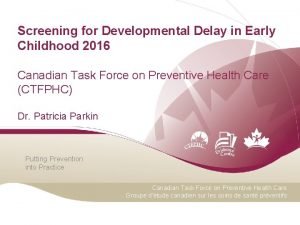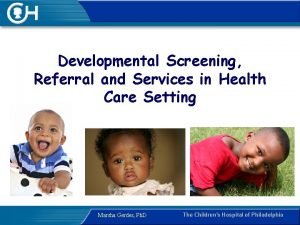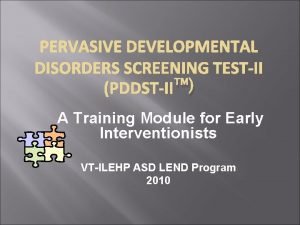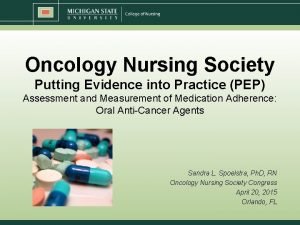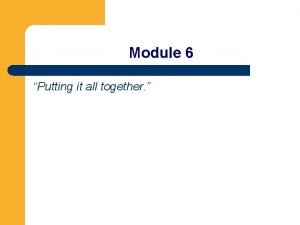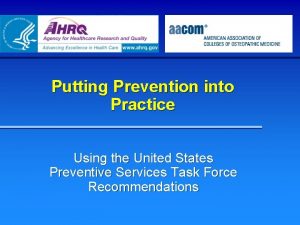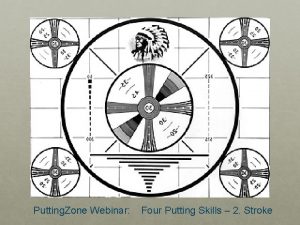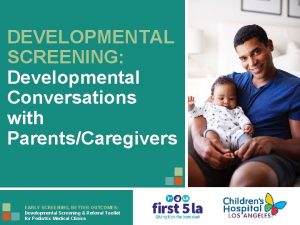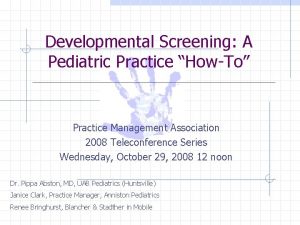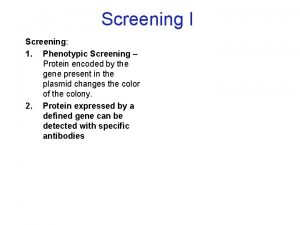Developmental Screening Putting It In Practice WILLIAM LEWIS





































- Slides: 37

Developmental Screening: Putting It In Practice WILLIAM LEWIS MD, FAAFP JANE HOLT DO CHERYL SHAW DO WEST VIRGINIA UNIVERSITY SCHOOL OF MEDICINE - EASTERN DIVISION HARPERS FERRY FAMILY MEDICINE

Harpers Ferry Family Medicine �Founded in 1982 as NHSC site �Site for Tri-State Children’s Health Improvement Consortium �Multi-specialty group with 14 providers plus residents � 36, 000 visits annually � 12, 000 pediatric visits (60% seen by family med)

WVU Rural Family Medicine Residency �First resident started in 1996 � 44 graduates � 5 -5 -5 residency � 75% of graduates for past five years practice in West Virginia

Background �United States Preventive Task Force Insufficient or inconsistent evidence to recommend for or against use of brief, formal screening instruments in primary care to detect speech and language delay in children up to 5 years of age

Background �Individuals with Disabilities Education Act Mandates the early identification of and intervention for developmental disabilities through development of community based systems All states receive federal funding for early intervention programs

Early Intervention �Evidence behind early intervention, though limited, shows long term improvement in outcomes �Early Intervention has been shown to Improve IQ Higher academic achievement Increased adult employment Decreased criminality

A Common Problem �Twelve to 16% of children in the United States have at least 1 delay �Half of these children will not be detected by the time they enter kindergarten

Morbidity �Developmental delays are associated with Poorer overall health status Higher rates of school failure Increased in-grade retention Increased special education placement

Screening �Screening tools are reasonably accurate Less than 25% of primary care physicians use a standardized screening tool 82% of PCPs cite time constraints as the most prominent barrier

Screening �Milestone checklists and clinical judgment are not enough Less than 30% identified by clinician judgment

Recommendations �Physician surveillance at all well child visits Identification of children at risk �Use of validated screening tools at regular, repeated intervals and when delay suspected �Parent-completed tools rather than directly administered tools

Recommendations �Prompt referral for comprehensive developmental assessment �Prompt referral to early intervention services

Screening Instruments �Directly Administered Combination of parent report and direct observation Provides in-depth information Requires time to complete Most useful as second stage screening tool Examples � Denver Developmental Screening Test II � Child Development Inventory

Screening Instruments �Parent Completed Parent report alone Time efficient � Completed in waiting room or at home Valid � Similar sensitivity and specificity to directly administered Less expensive Meet elements of the Patient Centered Medical Home Examples � Ages and Stages Questionnaire (ASQ) � Parents’ Evaluation of Development Status (PEDS)

Ages and Stages Parents’ Evaluation of Development Status Child Development Inventories Denver II Cost $199, CD unlimited downloads $60/100 survey forms and score sheets then $0. 30/survey $72/25 forms to start, then $1/screen $114/100 forms and 1 kit Time: Parent Completion 10 -20 minutes 5 minutes 30 minutes 0 Time: Provider Score and Interpret 1 -5 minutes 2 minutes 10 minutes 20 minutes Sensitivity 72% 74 -79% 80% 56 -83% Specificity 86% 70 -80% 96% 43 -80% Estimated Administrative Cost Per Visit $13 -17 $12 -16 NR $56 -60

What barriers do you see to screening?

What were we doing? �We had inconsistent screening I’ll know if there is a problem with the kid The screen that came in the EMR Full Denver Developmental Screening �We had unclear plan for problems Who gets referred �We did know who we would refer to

What did we want? �Consistent screening �Clear decision on who needed referral

What did we want to avoid? �Increasing physician time �Increased costs �Decreasing patient satsifaction

ASQ Pro’s Con’s �Uniform screening �Increased staff time �Parent engaged �Limited physician time Both training and during exam �Cost �Used by local birth to three program

Implementation �Identify Champions Not physicians Work at key points of process Nursing director Pediatric Care Coordinator

Implementation Screen all children at 9, 18 & 24 month well visits 1 week prior to visit ASQ mailed to up coming well visit Day of visit � Well visit are identified in huddle � Front desk gives ASQ to parents who forgot form Parents of toddlers never do this � Parent fills out prior to visit

Implementation � Nursing staff scores the form � Physician then conducts visit and makes recommendation Normal ASQ – regular well visit Borderline ASQ – repeat ASQ in two months Abnormal ASQ – refer � Pediatric care coordinator collects all ASQs and tacks follow up

The research �Objective To assess parent and providers views on the impact of implementing ASQ screening in a family medicine office.

Methods �IRB approval ✔ Thank you Eastern panhandle developmental screening champion !

Methods � ASQ’s were distributed In mail prior to their 9, 18, 24 month visits. Or given at office if parents left form at home � Convenience survey Parents with children ages 5 -24 months at well child check July and August at Harpers Ferry Family Medicine. � Groups those who completed an ASQ and those who did not as control. those who saw a Pediatrician, Family Medicine Attending, or resident. � The survey assessed for parents views on usefulness of ASQ time to complete form or perform ASQ concern about child’s development how informed parents feel about their child’s development.

Methods Cont. �Physicians at Harpers Ferry Family Medicine survey was distributed by email Returned to anonymous mailbox �Survey assessed preferred method of development screening usefulness of ASQ time to complete well child visit if the plan of action changed due to ASQ use. �Survey questions were likert scale, yes/no and fill in for time taken to complete.

Results � 85 parent surveys were returned out of ___ visits with ASQ’s over 2 month period � 15 of 30 physician surveys were obtained over the 2 month period.

Results Parental Data �No significant difference in how informed parents felt about their childs development p = 0. 07

Results Parental Data (cont. ) �No significant difference in parents concern for childs development. P = 0. 27 �All parents felt as though their child had been developmentally screened during their visit All 85 parents answered yes to if their child had been developmentally screened at that days visit.

Results Parental Data (cont. ) �usefulness of survey 40. 5 percent felt the ASQ was useful

Results Physician Data (cont. ) �Physician data �No significant difference in time to complete their exam compared to their screening t test p = 0. 39. Average time to complete the exam with asq was 28 min. with preferred method of screening 30 minutes.

Results Physicians (cont. ) �Significant difference in providers for well child visits between 5 -24 months between pediatrician vs. attending vs. resident vs. physician assistant With pediatricians seeing 70. 5 % of patients. �A chi square p = 5. 78177 E -14.

QUESTIONS?

References �Council on Children with Disabilities, Section on Developmental Behavioral Pediatrics, Bright Futures Steering Committee and Medical Home Initiatives for Children With Special Needs Project Advisory Committee (2006). Identifying Infants and Young Children With Developmental Disorders in the Medical Home: An Algorithm for Developmental Surveillance and Screening. Pediatrics 2006; 118; 405.

References �Hamilton S. Screening for Developmental Delay: Reliable, Easy-To-Use tools. J Family Practice. 2006; 55(5): 415 -422. �Mackrides P, Ryherd S. Screening for Developmental Delay. American Family Physician. 2011; 84(5): 544549.

�Nutting P. , Miller, W. , Crabtree, B. , Jaen, C. , Stewart, E. , Stange, K. (2009). Initial lessons from the first national demonstration project on practice transformation to a patient-centered medical home. Annals of Family Medicine Vol 7, No. 3, May/June 2009
 Denver developmental screening test
Denver developmental screening test Developmental screening vs surveillance
Developmental screening vs surveillance Trivandrum developmental screening chart
Trivandrum developmental screening chart Trivandrum developmental screening test
Trivandrum developmental screening test Pddst
Pddst Trivandrum developmental screening chart
Trivandrum developmental screening chart Non physical fences example
Non physical fences example Putting evidence into practice
Putting evidence into practice Practice: putting it all together
Practice: putting it all together Putting it into practice
Putting it into practice Putting prevention into practice
Putting prevention into practice Putting principles into practice
Putting principles into practice Putting-out system
Putting-out system What is nasreen putting chocolate on?
What is nasreen putting chocolate on? When was the loom invented
When was the loom invented Putting-out system
Putting-out system Puts the pieces together if in use maybe
Puts the pieces together if in use maybe Putting objects in perspective
Putting objects in perspective The order of putting on ppe
The order of putting on ppe Putting it all together motion answer key
Putting it all together motion answer key Ordering fractions
Ordering fractions Putting people first 2007
Putting people first 2007 Putting-out system
Putting-out system Classification of polynomial
Classification of polynomial Putting the enterprise into the enterprise system
Putting the enterprise into the enterprise system Letters put together
Letters put together A 3-d work of art created by shaping or combining materials
A 3-d work of art created by shaping or combining materials Putting zone
Putting zone Putting to death the old man
Putting to death the old man Enterprise
Enterprise Putting stance ball position
Putting stance ball position Putting a package together
Putting a package together Strategic organization means putting a speech together
Strategic organization means putting a speech together Putting on the new man
Putting on the new man Putting two words together
Putting two words together Bridge introduction paragraph examples
Bridge introduction paragraph examples Putting it all together
Putting it all together Putting it all to bed during project closeout includes
Putting it all to bed during project closeout includes
